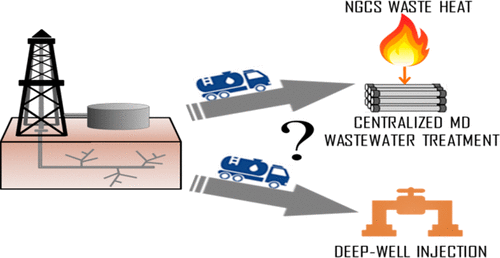当前位置:
X-MOL 学术
›
ACS ES&T Eng.
›
论文详情
Our official English website, www.x-mol.net, welcomes your
feedback! (Note: you will need to create a separate account there.)
Spatial Analysis of Membrane Distillation Powered by Waste Heat from Natural Gas Compressor Stations for Unconventional Oil and Gas Wastewater Treatment in Weld County, Colorado
ACS ES&T Engineering ( IF 7.4 ) Pub Date : 2020-11-13 , DOI: 10.1021/acsestengg.0c00049 Cristian A. Robbins 1 , Kenneth H. Carlson 1 , Shane D. Garland 2 , Todd M. Bandhauer 2 , Brandi M. Grauberger 2 , Tiezheng Tong 1
ACS ES&T Engineering ( IF 7.4 ) Pub Date : 2020-11-13 , DOI: 10.1021/acsestengg.0c00049 Cristian A. Robbins 1 , Kenneth H. Carlson 1 , Shane D. Garland 2 , Todd M. Bandhauer 2 , Brandi M. Grauberger 2 , Tiezheng Tong 1
Affiliation

|
The effective treatment of unconventional oil and gas (UOG) wastewater is a promising and potentially necessary strategy of wastewater management in the UOG industry. While tremendous efforts have been focused on the development of treatment technologies, logistical considerations such as wastewater transportation have been rarely studied in the literature. In this study, we applied spatial analysis tools based on geographic information systems to quantitatively investigate the effects of transportation distance and cost on centralized wastewater treatment (CWT) and deep-well injection (DWI) in Weld County of Colorado, a major UOG-producing state in the United States. CWT using membrane distillation technology powered by waste heat from natural gas compressor stations (NGCSs) was used as the model wastewater treatment approach in our analysis. By analyzing 7583 active UOG production wells, we demonstrate that the distance and cost of wastewater transportation for CWT are comparable to those for DWI in Weld County and that the comparison between CWT and DWI is dependent on the scale of analysis. We also correlated the waste heat availability with the potential UOG wastewater treatment demand at 35 NGCSs. Our analysis shows that the abundance of available waste heat does not always match wastewater treatment demand at NGCSs, requiring a diversion of wastewater that further increases the transportation distance and cost. Our work indicates the importance of logistical considerations in evaluating the viability of CWT for UOG wastewater management. The spatial analysis framework demonstrated in this study is a critical component complementary to the current efforts of treatment technology development, in order to better evaluate the viability and facilitate wide adoption of UOG wastewater treatment via a systems engineering approach.
中文翻译:

科罗拉多维尔德县天然气压缩机站余热驱动膜蒸馏的非常规油气废水处理的空间分析
有效处理非常规石油和天然气(UOG)废水是UOG行业废水管理的有希望且潜在的必要策略。尽管在处理技术的发展上已付出了巨大的努力,但在文献中很少研究物流方面的考虑因素,例如废水的运输。在这项研究中,我们应用了基于地理信息系统的空间分析工具来定量研究运输距离和成本对科罗拉多州韦尔德县(主要生产UOG的地区)的集中式废水处理(CWT)和深井注入(DWI)的影响美国的州。在我们的分析中,使用由天然气压缩机站(NGCSs)的余热提供动力的采用膜蒸馏技术的CWT作为废水处理模型。通过分析7583口活跃的UOG生产井,我们证明了CWT的废水运输距离和成本与Weld县的DWI相当,并且CWT与DWI的比较取决于分析规模。我们还将35个NGCS处的废热可用性与潜在的UOG废水处理需求相关联。我们的分析表明,大量可用的余热并不总是与NGCS上的废水处理需求匹配,这需要对废水进行分流,这进一步增加了运输距离和成本。我们的工作表明,在评估CWT用于UOG废水管理的可行性时,后勤考虑的重要性。
更新日期:2020-11-13
中文翻译:

科罗拉多维尔德县天然气压缩机站余热驱动膜蒸馏的非常规油气废水处理的空间分析
有效处理非常规石油和天然气(UOG)废水是UOG行业废水管理的有希望且潜在的必要策略。尽管在处理技术的发展上已付出了巨大的努力,但在文献中很少研究物流方面的考虑因素,例如废水的运输。在这项研究中,我们应用了基于地理信息系统的空间分析工具来定量研究运输距离和成本对科罗拉多州韦尔德县(主要生产UOG的地区)的集中式废水处理(CWT)和深井注入(DWI)的影响美国的州。在我们的分析中,使用由天然气压缩机站(NGCSs)的余热提供动力的采用膜蒸馏技术的CWT作为废水处理模型。通过分析7583口活跃的UOG生产井,我们证明了CWT的废水运输距离和成本与Weld县的DWI相当,并且CWT与DWI的比较取决于分析规模。我们还将35个NGCS处的废热可用性与潜在的UOG废水处理需求相关联。我们的分析表明,大量可用的余热并不总是与NGCS上的废水处理需求匹配,这需要对废水进行分流,这进一步增加了运输距离和成本。我们的工作表明,在评估CWT用于UOG废水管理的可行性时,后勤考虑的重要性。











































 京公网安备 11010802027423号
京公网安备 11010802027423号